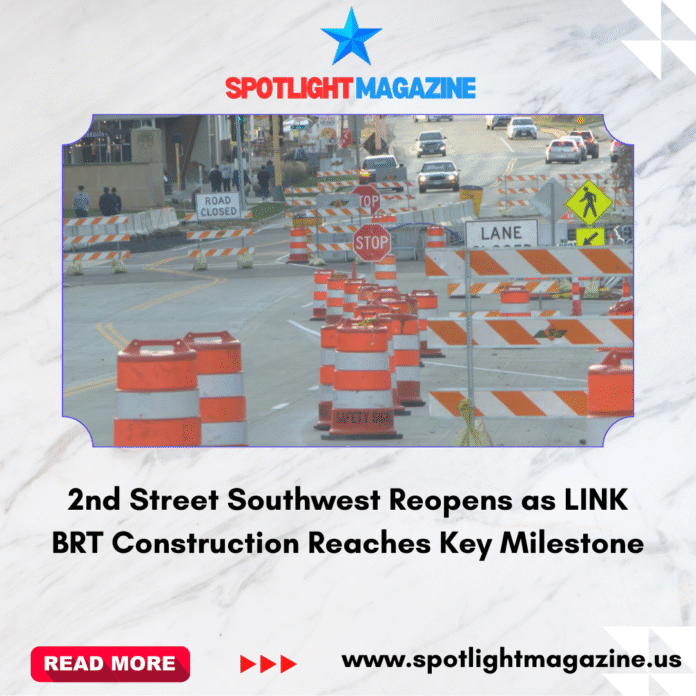A significant portion of 2nd Street Southwest is set to reopen on Monday, Nov. 24, marking the first time traffic has been allowed through the corridor since late August. The stretch between 11th and 14th Avenues has been closed for months as part of the ongoing LINK Bus Rapid Transit (BRT) project, a two-year effort aimed at transforming public transit in downtown Rochester.
City officials say the reopening represents a major milestone: roughly 25% of the overall project is now complete. Construction crews spent the fall replacing underground utility infrastructure—critical work that had to be finished before the next stages of the project could begin.
“We’ve completed about 25% of the project so far. We’ve replaced a lot of the infrastructure for the underground utilities that we needed to get done,” said Rochester Construction Manager Josh Defrang.
The LINK BRT project, budgeted at $196 million, will introduce fare-free rides on all-electric, 60-foot buses running along a 2.8-mile route through the downtown corridor. City leaders hope the system will improve reliability, reduce congestion, and support Rochester’s growing population, particularly those who work at or travel through the Mayo Clinic area.
The next phase of construction will shift focus to major structural features of the project, including a new pedestrian tunnel and the St. Marys Transit Center—key components designed to improve safety and accessibility.
“It will be opening up traffic on the southern half with one lane in each direction to allow traffic to flow through the area while we begin construction on the tunnel and underground pedestrian tunnel,” Defrang explained.
Businesses Feel the Strain
While the project promises long-term transit improvements, the extended closure has taken a heavy toll on businesses located along the blocked-off corridor. Some shop owners reported steep declines in customer traffic as visibility and accessibility dropped dramatically.
Among the hardest hit is Francisco’s Caribbean restaurant, owned by Lisette Nunez-James. She says her revenue has fallen to about 30% of what she normally earns at this point in the year.
“Me as an employee, I’m not paying myself right now. I’m paying [other employees] just to be able to keep going,” Nunez-James said.
She believes her restaurant might not have survived the construction period had she not owned the building. “We’re hanging in there, but we could be better. But again, because we own the real estate, that’s why we’re able to be here. And that’s the reality,” she said.
Nunez-James also expressed hope that the city—or even Mayo Clinic, which sees significant benefits from improved transit—might help offset some of the financial strain businesses have endured.
“I wish that the city would have provided some kind of grant or something to give us a little support during this time. Or maybe Mayo Clinic say, ‘hey, let’s throw a little money at the problem to keep you guys going,’” she said.
What Comes Next
The newly reopened segment of 2nd Street Southwest is expected to remain open through the winter months, offering temporary relief to both drivers and businesses. However, city officials warn the same area will likely face another four- to six-week closure next summer as construction continues.
Despite the disruptions, the city maintains that the long-term benefits of the LINK BRT system will outweigh the temporary inconveniences. The full project is scheduled for completion in late 2027, at which point Rochester will have its first dedicated BRT line—designed to move thousands of riders quickly and sustainably through the city’s core.


